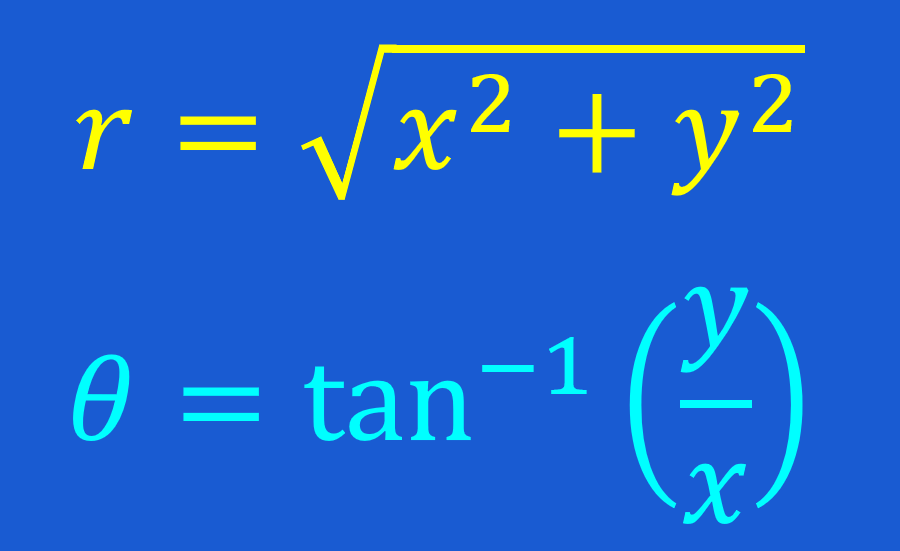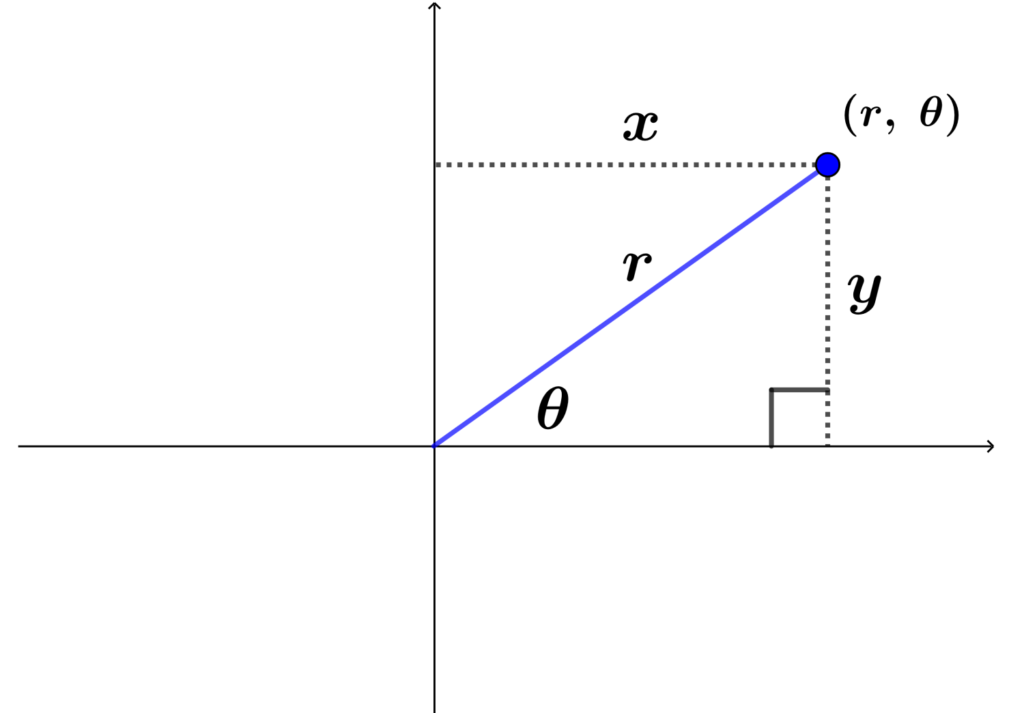Polar coordinates are written in the form (r, θ), where r is the distance and θ is the angle. These coordinates can be related to rectangular or Cartesian coordinates using trigonometry, a right triangle, and the Pythagorean theorem. It turns out that we use the tangent function to find the angle and the Pythagorean theorem to find the distance, r.
Here, we will learn about the formulas that we can use to transform from rectangular to polar coordinates. Also, we will solve some practice problems to apply the learned formulas.
TRIGONOMETRY

Relevant for…
Learning to transform from rectangular to polar coordinates.
TRIGONOMETRY

Relevant for…
Learning to transform from rectangular to polar coordinates.
How to transform from rectangular coordinates to polar coordinates?
We remember that the rectangular coordinates are written in the form $latex (x, y)$ and the polar coordinates are written in the form $latex (r, \theta)$, where r is the distance from the origin to the point and θ is the angle formed between the line and the x-axis. These coordinates are related using trigonometry.
Let’s look at the following diagram:

Using the right triangle, we can obtain relationships for the polar coordinates in terms of the rectangular coordinates. We note that the x-coordinates form the base of the right triangle and the y-coordinates form the height.
Furthermore, we see that the distance r corresponds to the hypotenuse of the triangle. Therefore, we can use the Pythagorean theorem to find the length of the hypotenuse:
$latex {{r}^2}={{x}^2}+{{y}^2}$
| $latex r=\sqrt{{{x}^2}+{{y}^2}}$ |
The angle θ can be found using the tangent function. Recall that the tangent of an angle is equal to the opposite side divided by the adjacent side. The opposite side is the y component and the adjacent side is the x component. Therefore, we have:
| $latex \theta=\tan^{-1}(\frac{y}{x})$ |
Since the range of the inverse tangent function is from $latex – \frac{\pi}{2}$ to $latex \frac{\pi}{2}$, this does not cover all four quadrants of the Cartesian plane, so many times, the calculator may give wrong value for $latex {{\tan}^{-1}}$.
This depends on the quadrant in which the point is located. We can use the following to fix this:
| Quadrant | Value of $latex {{\tan}^{-1}}$ |
| I | We use the value of the calculator |
| II | We add 180° to the calculator value |
| III | We add 180° to the calculator value |
| IV | We add 360° to the calculator value |
Rectangular to polar coordinates – Examples with answers
What has been learned about the transformation of rectangular coordinates to polar coordinates is used to solve the following examples. Try to solve the problems yourself before looking at the answer.
EXAMPLE 1
If we have the rectangular coordinates (3, 4), what is their equivalent in polar coordinates?
Solution
We have the values $latex x = 3, ~y = 4$. We use the formulas given above along with these values to find the polar coordinates. Therefore, the value of r is found using the Pythagorean theorem:
$latex r=\sqrt{{{x}^2}+{{y}^2}}$
$latex r=\sqrt{{{3}^2}+{{4}^2}}$
$latex r=\sqrt{9+16}$
$latex r=\sqrt{25}$
$latex r=5$
Now, we find the value of θ using the inverse tangent:
$latex \theta={{\tan}^{-1}}(\frac{y}{x})$
$latex \theta={{\tan}^{-1}}(\frac{4}{3})$
$latex \theta=0.93$ rad
Both the component in x and the component in y are positive, so the point is in the first quadrant. This means that the angle obtained is correct.
The polar coordinates are (5, 0.93 rad).
EXAMPLE 2
We have the rectangular coordinates (-1, 3). What is its equivalent in polar coordinates?
Solution
We can observe the values $latex x = -1, ~ y = 3$. We find the value of r using the Pythagorean theorem along with the given values:
$latex r=\sqrt{{{x}^2}+{{y}^2}}$
$latex r=\sqrt{{{(-1)}^2}+{{3}^2}}$
$latex r=\sqrt{1+9}$
$latex r=\sqrt{10}$
To find the value of θ, we use the inverse tangent:
$latex \theta={{\tan}^{-1}}(\frac{y}{x})$
$latex \theta={{\tan}^{-1}}(\frac{3}{-1})$
$latex \theta=-1.25$ rad
The component in x is negative and the component in y is positive, so the point is in the second quadrant. This means that we have to add π to the angle obtained. The correct angle is $latex \theta=-1.25+\pi=1.89$ rad.
The polar coordinates are ($latex \sqrt{10}$, 1.89 rad).
EXAMPLE 3
If we have the Cartesian coordinates (-3, -9), what are the polar coordinates?
Solution
We have the values $latex x = -3, ~ y = -9$. The value of r is found using the Pythagorean theorem:
$latex r=\sqrt{{{x}^2}+{{y}^2}}$
$latex r=\sqrt{{{(-3)}^2}+{{(-9)}^2}}$
$latex r=\sqrt{9+81}$
$latex r=\sqrt{90}$
$latex r=3\sqrt{10}$
The value of θ is:
$latex \theta={{\tan}^{-1}}(\frac{y}{x})$
$latex \theta={{\tan}^{-1}}(\frac{-9}{-3})$
$latex \theta=1.25$ rad
Both the component in x and the component in y are negative, so the point is in the third quadrant. This means that we have to add π to the angle obtained. The correct angle is $latex \theta=1.25+\pi=4.39$ rad.
The polar coordinates are ($latex 3\sqrt{10}$, 1.25 rad).
EXAMPLE 4
A point is defined by (4, -5) in rectangular coordinates. How can we define the point in polar coordinates?
Solution
We can have the values $latex x = 4, ~ y = -5$. We use these values and the Pythagorean theorem to find the value of r:
$latex r=\sqrt{{{x}^2}+{{y}^2}}$
$latex r=\sqrt{{{4}^2}+{{(-5)}^2}}$
$latex r=\sqrt{16+25}$
$latex r=\sqrt{41}$
Now, we use the inverse tangent to find the value of θ:
$latex \theta={{\tan}^{-1}}(\frac{y}{x})$
$latex \theta={{\tan}^{-1}}(\frac{4}{-5})$
$latex \theta=-0.67$ rad
The component in x is positive and the component in y is negative, so the point is in the fourth quadrant. This means that we have to add 2π to the angle obtained. The correct angle is $latex \theta=-0.67+2\pi=5.61$ rad.
The polar coordinates are ($latex \sqrt{41}$, -0.67 rad).
Rectangular to polar coordinates – Practice problems
Solve the following problems using the formulas seen above to transform from rectangular to polar coordinates. If you need help with this, you can look at the solved examples above.
See also
Interested in learning more about polar coordinates? Take a look at these pages:



